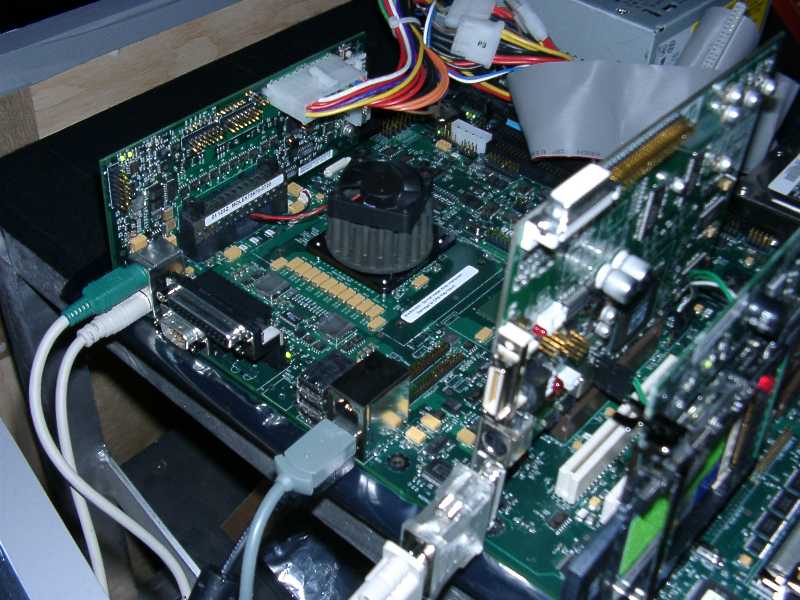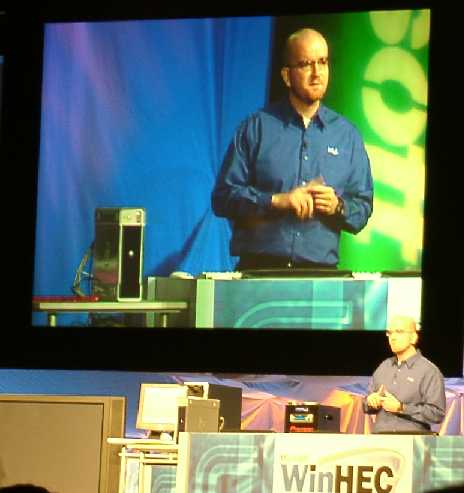
Intel Demos Banias
By Van Smith
Date: April 18, 2002
At WinHEC 2002 today, semiconductor vendor Intel Corporation gave a debut demonstration of Banias, a new CPU designed for low power mobile applications. In a presentation led by Paul Otellini, COO of Intel, week-old Banias silicon formed the heart of a short, functional demo.

Intelís Paul Otellini
Intelís current flagship, the Pentium 4, has power requirements that are far too demanding for compact, long battery life notebooks. Banias is the chipmakerís answer for this market space starting in 2003.

The Banias demo
The demo itself consisted of a very brief playback of an old Saturday Night Live skit. Rendered in a small window, the task was relatively untaxing, but did provide proof of operating silicon.
We have exclusive photographs of the demonstration system below. Banias, developed in Israel, is under the tall, slim, cylindrical heat sink in the center of the photograph.

The Banias demonstration platform
Although Mr. Otellini restated Intelís position that a wireless component is integral to the Banias platform, the system demonstrated today used a wireless NIC. The Santa Clara, California-based MPU-maker is expected to embed wireless functionality in the accompanying ďOdemĒ chipset next year.
===================================
Banias Details
Although Mr. Otellini divulged very few technical facts regarding Banias, we have a list of details that we believe are accurate.
Banias is essentially a Pentium III core fitted to a low-voltage 400 MHz Pentium 4 bus. Some architectural changes had to be made to the PIII core to accommodate a doubled 64-byte L2 line size.
The Level 2 cache size is 1MB. The cache was enlarged to, in part, reduce thermal density. Banias will be introduced on a 0.13-micron copper process next year. Certain Japanese mobile OEMs are expected to have working silicon shortly.
Initially, Banias will ship at 1.6 GHz and will consume roughly 24.5W. From a power consumption standpoint, this compares poorly with the shipping AMD (Thoroughbred) Mobile Athlon XP launched earlier this week, which may demand less than 20W at the same clock speed.
===================================
Hyper-Threading Enabled 3 GHz Pentium 4 Shown
Following the Banias presentation, Mr. Otellini proclaimed that Intelís Hyper-Threading will likely be a more important technology than MMX and other key Intel technologies. Hyper-Threading is a thread-level technique using a single CPU to present two logical processors to the OS enabling more efficient management of computational resources.
In the demonstration, a 3GHz air-cooled Hyper-Threading enabled Pentium 4 system outperformed by about 20% a non-HT enable 3GHz P4 system in a video encoding task. In a second demo, playing a video while running Windows Media Encoder, showed smoother playback for the HT-enable P4 system.
Early third party tests have shown that benefits from Hyper-Threading are uneven depending on the application. According to Mr. Otellini, Intel is committed to improve support for this technology among software vendors.
A second concern regard Hyper-Threading enabled Pentium 4s is the increased power consumption for an already power hungry chip. Although the Pentium 4 demoed today at WinHEC ran inside a relatively compact chassis and was ďair cooled,Ē the fan noise was excessive and audible throughout the auditorium, perhaps adding some weight to these fears.

The compact chassis housing the 3GHz Hyper-Threading enabled Pentium 4 is visible in the monitor view.
===================================
Pssst!† We've updated our Shopping Page.
===================================